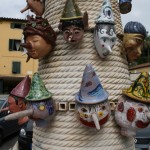Inaugurated in 1956, the Pinocchio Park is no ordinary theme park, but rather a precious masterpiece created by artists of great character working together. The literary itinerary, marked out by mosaics, buildings and sculptures set amidst the greenery, emerges from an inspired combination of art and nature. The path is winding, and the dense vegetation means that every stage on the route comes as an unexpected surprise, with the very plants and trees contributing to create the atmosphere and the episodes in the story of the Adventures of Pinocchio. The Park itself is the site of constantly renewed cultural activities that are always mindful of its roots: exhibitions of art and illustrations inspired by children’s literature and the Story of Pinocchio, puppet-making workshops, puppet and marionette shows and minstrels enliven the visit to the Park, depending on the season.
The Pinocchio Park could not have been set up anywhere else but in Collodi, where the ancient village has remained as it was hundreds of years ago, a cascade of houses that ends behind Villa Garzoni and its scenographic Garden. It was here that Carlo Lorenzini’s mother was born, and here that he spent his childhood with his grandparents, the Orzali. This is no ordinary theme park, but rather an evocative precious masterpiece created by great artists working together where we can retrace a tale that comes to life through the encounter between the images expressed in the symbolic language of art and the visitor’s own imagination. The resulting enjoyment is spontaneous and natural, thanks to the beauty of the art and the surroundings. The original idea for the monumental complex came to the Mayor of Pescia, Professor Rolando Anzilotti, in 1951. Consequently he set up the Committee for the Monument to Pinocchio and invited leading artists to enter the competition. No less than eighty-four sculptors responded to the invitation: the joint winners were Emilio Greco with Pinocchio and the Fairy and Venturino Venturini with the Square of the Mosaics. In 1956 the famous bronze group that symbolically represents the metamorphosis of Pinocchio, and the extraordinary mosaics showing the principal episodes from the Adventures were unveiled in an area designed by the architects Renato Baldi and Lionello De Luigi. In 1963 came the Osteria del Gambero Rosso, housing the restaurant of the same name, designed by Giovanni Michelucci, with red bays that recall the pincers of the crab; in 1972 the Park was enlarged by the addition of the Land of Toys, a fantastic itinerary stretching over a hectare of Mediterranean maquis, designed by Pietro Porcinai and hosting twenty-one sculptures in bronze and steel by Pietro Consagra and constructions by Marco Zanuso, evoking the plot of the Adventures. Finally, in 1987, came the “Laboratory of Words and Figures”, designed and created by Carlo Anzilotti to an idea by Giovanni Michelucci.

0 Comments